The 1953 dime is a 10-cent coin issued by the US Mint in 1953. It is part of the Roosevelt Dime series. The 1953 dimes are already 70 years old at this time.
Because the 1953 dime is made of silver and an old coin, many coin enthusiasts would like to add it to their collection.
What Is the 1953 Roosevelt Dime Made Of?
The 1953 Roosevelt dime is made of 90% silver and 10% copper, weighing 2.50 grams, and has an Actual Silver Weight (ASW) of 0.0723 oz. The silver content’s fineness is 0.90. The edge is reeded while its diameter is 17.9 millimeters.
John Sinnock designed the Roosevelt dime until now; his design has remained unchanged. On the obverse, you’ll find the image of Roosevelt facing to the left. While inscriptions can be read, such as LIBERTY, IN GOD WE TRUST, 1953, and the designer’s initials.
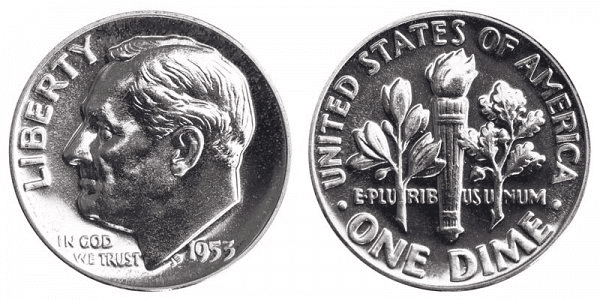
On the reverse, you’ll find the Liberty Torch flanked by olive and oak branches. The words “E PLURIBUS UNUM,” which means out of many, run across the coin. The inscription, “UNITED STATES OF AMERICA,” arches above the coin, then below the coin arches “ONE DIME.”
The Roosevelt Dime is quite interesting because of how Roosevelt was chosen as its main figure. In 1945, President Franklin D. Roosevelt died, and to honor the president, Congress would like to add him to a US coin.
The question was, “Which coin?”
The answer is the dime. The reason was that Roosevelt suffered from polio; because of this, one of his goals in life was to help people with disabilities. That was when he helped in starting the March of Dimes organization.
The main method for the organization to get funding is encouraging people to give as little as a dime to the cause they are fighting for. Therefore, the dime was the perfect choice for Roosevelt’s coin.
1953 Roosevelt Dime Varieties
The US Mint produced more than 229 million Roosevelt dimes in 1953, lower than in 1952 and 1954.
There are four official standard 1953 Roosevelt dime varieties. In terms of design, these varieties aren’t different from each other except for their mint marks.
Here’s a quick look at the 1953 Roosevelt dime varieties, along with their mintage figure:
| Variety | Mint Location | Mintage |
| 1953 D Roosevelt Dime | Denver | 136,433,000 |
| 1953 S Roosevelt Dime | San Francisco | 39,180,000 |
| 1953 P Roosevelt Dime | Philadelphia | 53,490,120 |
| 1953 Proof Roosevelt Dime | Philadelphia | 128,800 |
| Total | 229,231,920 |
Take a look at the 1953 dime varieties in greater detail below.
1953 D Roosevelt Dime
Year of minting: 1953
Mint Mark: D
Place of minting: Denver
Quantity produced: 136,433,000
Face Value: $0.10 (ten cents)
Price: $2.10 to $2.60 (circulated condition)
Mass: 2.50 grams
Edge: Reeded
Designer: John R. Sinnock
Composition: 90% Silver and 10% Copper
Diameter: 17.90 millimeters
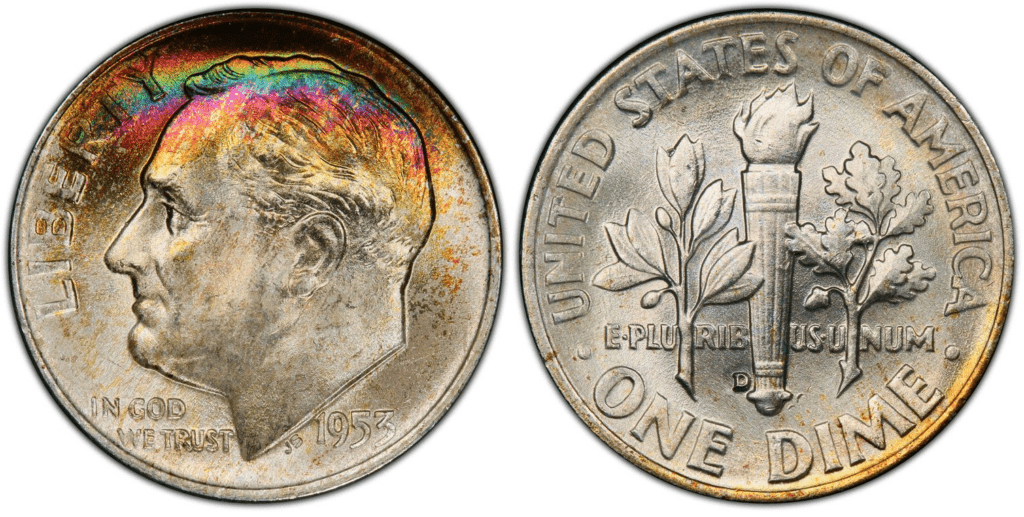
The Denver Mint produced more than 136 million dimes in 1953.
If you notice, there’s a big shift in the production between the Philadelphia and Denver Mint. In the past, it was always the Philadelphia Mint that produced the most number of coins. However, after World War II, more and more people were migrating to the West, which led to higher demand for coins from the Denver Mint.
1953 S Roosevelt Dime
Year of minting: 1953
Mint Mark: S
Place of minting: San Francisco
Quantity produced: 39,180,000
Face Value: $0.10 (ten cents)
Price: $2.10 to $2.60 (circulated condition)
Mass: 2.50 grams
Edge: Reeded
Designer: John R. Sinnock
Composition: 90% Silver and 10% Copper
Diameter: 17.90 millimeters
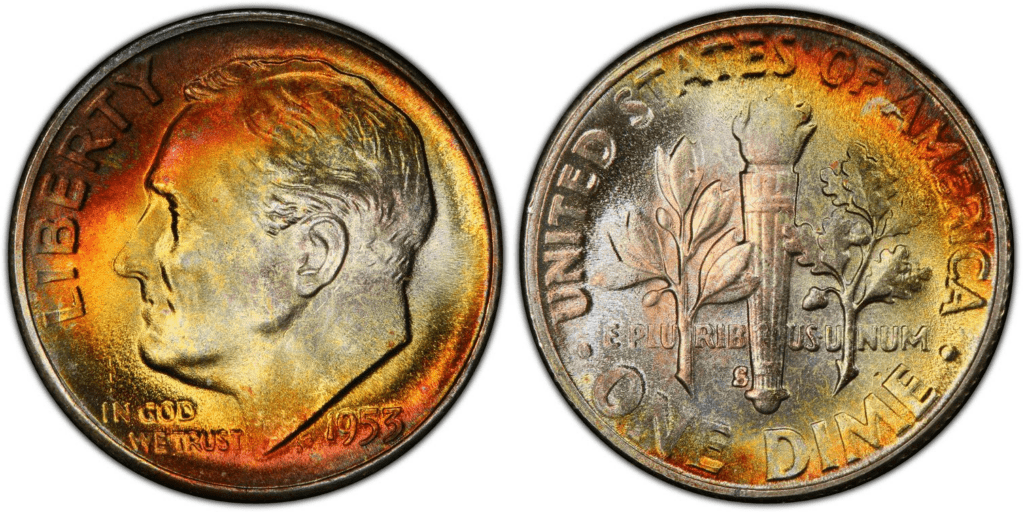
For some reason, a lot of collectors find it more interesting to get as many coins from the San Francisco Mint as possible. That’s why a lot of collectors hoarded 1953 S dimes.
While there are a lot of 1953 S dimes that are in Gem condition, you would quickly notice how poorly struck these coins were. You can see that the coin has soft and somewhat blurry engraved elements.
1953 P Roosevelt Dime
Year of minting: 1953
Mint Mark: None
Place of minting: Philadelphia
Quantity produced: 53,490,120
Face Value: $0.10 (ten cents)
Price: $2.10 to $2.60 (circulated condition)
Mass: 2.50 grams
Edge: Reeded
Designer: John R. Sinnock
Composition: 90% Silver and 10% Copper
Diameter: 17.90 millimeters
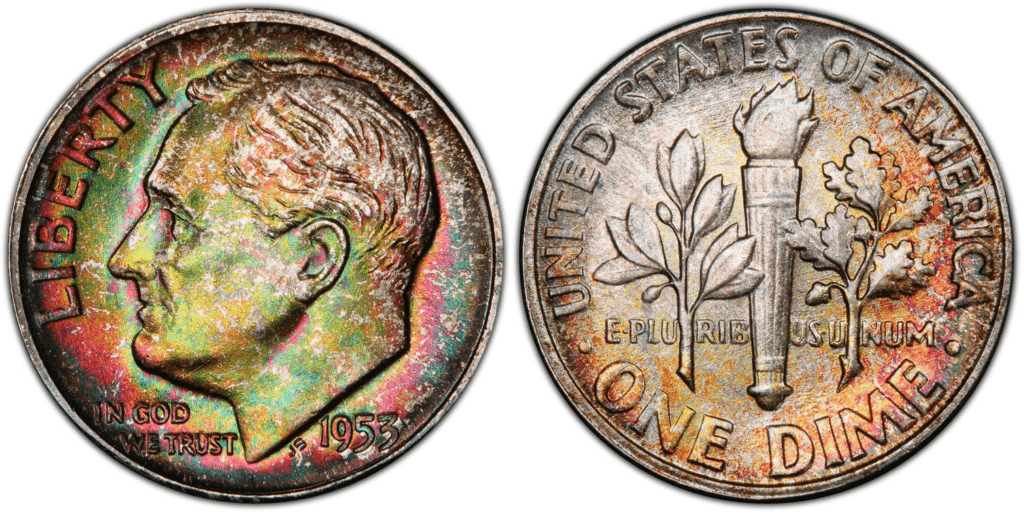
There were about 53 million dimes produced by the Philadelphia Mint in 1953. Finding 1953 P dimes up to MS 66 condition should be doable. However, higher grades can be very elusive to many. The reason is that in the 1950s, poor quality control was prevalent in the Philadelphia Mint.
1953 Proof Roosevelt Dime
Year of minting: 1953
Mint Mark: None
Place of minting: Philadelphia
Quantity produced: 53,490,120
Face Value: $0.10 (ten cents)
Price: $15 or more (uncirculated condition)
Mass: 2.50 grams
Edge: Reeded
Designer: John R. Sinnock
Composition: 90% Silver and 10% Copper
Diameter: 17.90 millimeters
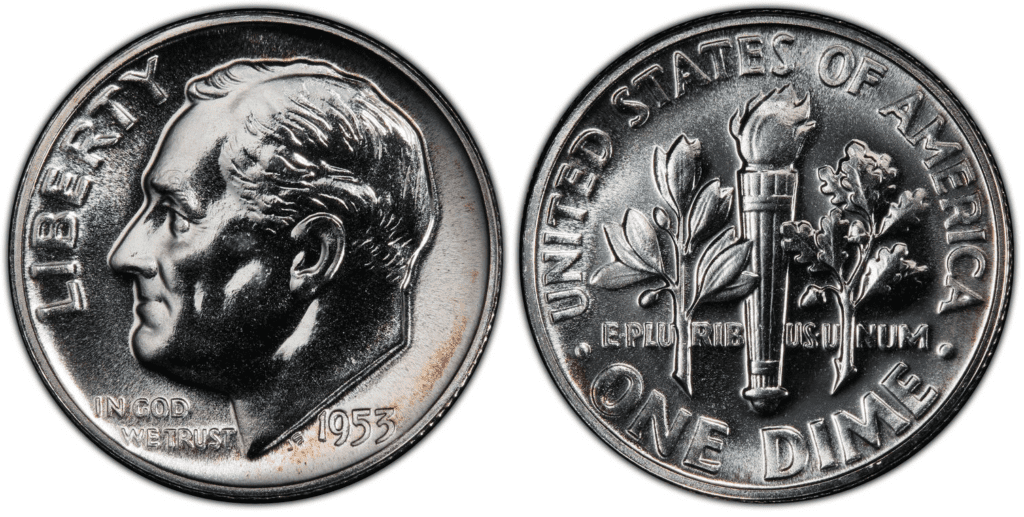
The 1953 proof dime should be easy to find up to PR 67. However, Cameo and Deep Cameo examples are more difficult to find. As a proof coin, this dime variety is more expensive than standard dimes.
List Of 1953 Roosevelt Dime Errors
A few examples of 1954 Roosevelt dime errors are known to exist. Due to mechanical error and sometimes human error, dimes can be improperly struck. Errors can happen from when the planchet was cut to when the dime was released from the Mint.
Here are the common errors in the 1953 Roosevelt dimes:
Repunched Mintmark (RPM)
The repunched mint mark errors happen when the mintmark is struck twice on the planchet. The error isn’t obvious if the strike’s angle is the same. However, if it is different, you will observe a doubling in the mintmark.
Here’s an example of a 1953 dime with a repunched mintmark error:
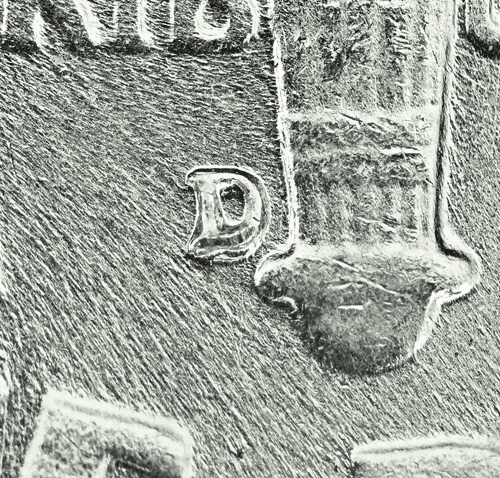
Cud error
The cud error happens when there’s a gouge or dents on the die. Thus, the coin produces a raised portion or a “bump” on its surface when the die hits the planchet.
Here’s an example of a 1953 dime cud error:
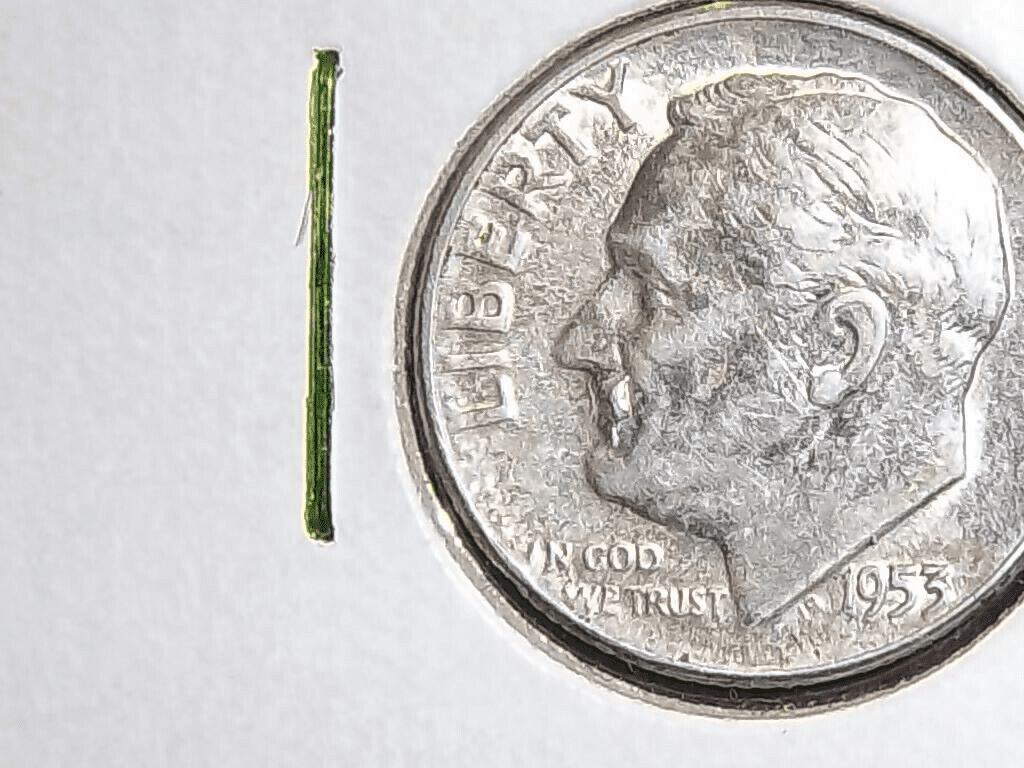
Look closely at the upper lip or mouth of Roosevelt. You will find a bump.
Strike-through error
Strike-through errors happen when a foreign material gets stuck on the die or planchet. The die then strikes through the foreign material, leaving an unnecessary mark on the coin.
Here’s an example of a strike-through error found in a 1953 dime:
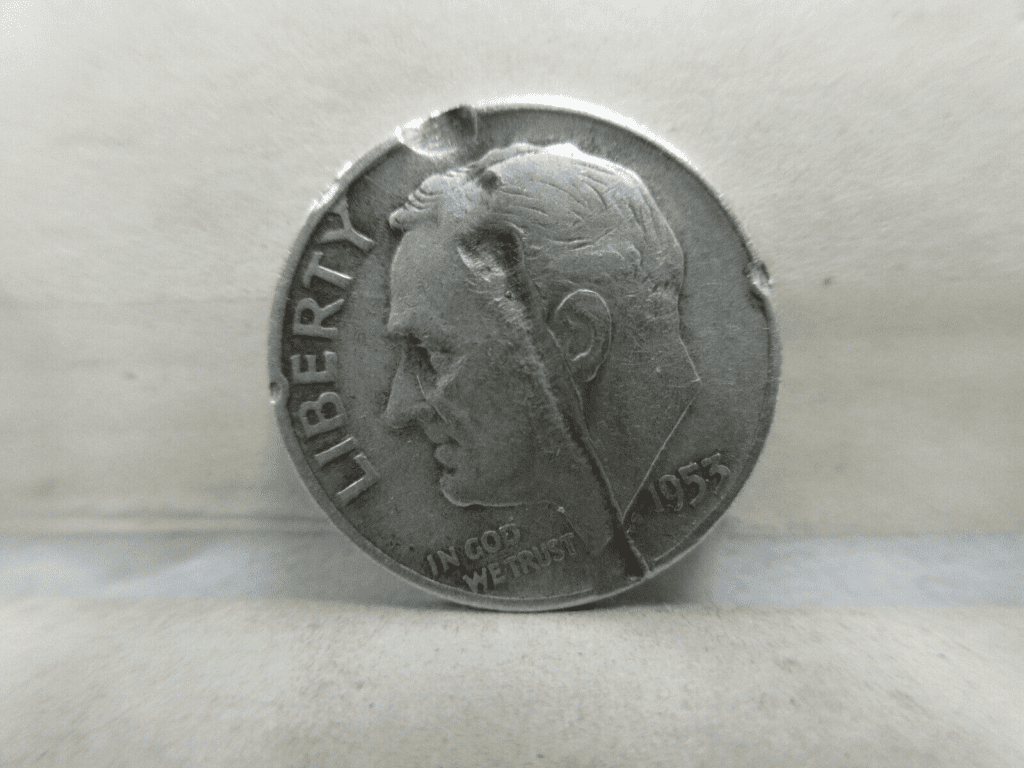
The foreign object in this error coin is more likely to be a metal clipping. Foreign objects can also be grease, dust, dirt, and cloth.
How Much Is 1953 Roosevelt Dime Worth Today?
The 1953 Roosevelt dime has a face value of 10 cents. Its melt value is $1.6095, which can increase or decrease depending on the market value of silver. The usual price of a circulated 1953 Roosevelt dime is $2.10 to $2.60.
Although it may sound that the 1953 Roosevelt dime is cheap, that shouldn’t fool you. Some 1953 dimes are valuable in the eyes of collectors.
Take a look at this table of auction records to better understand the value of the 1953 dime:
| Coin | Condition | Grade | Sold date | Sold by | Value |
| 1953 D Roosevelt Dime | Superb Gem Uncirculated | MS 68 (Full Band) | October 24, 2019 | Heritage Auctions | $4,800 |
| 1953 S Roosevelt Dime | Superb Gem Uncirculated
|
MS 68 (Full Band) | August 2, 2017 | Heritage Auctions | $4,700 |
| 1953 Proof Roosevelt Dime | Superb Gem Uncirculated | PR 68 – Deep Cameo | May 5, 2004 | Heritage Auctions | $3,680 |
| 1953 P Roosevelt Dime | Superb Gem Uncirculated | MS 67 (Full Band) | June 1, 2008 | Bowers & Merena | $2,070 |
How Does The Grading System Work?
Professional numismatists joined in the 1970s and established CoinGrading standards, known as the Sheldon Scale. These numismatists now assign grades at key places on the seventy-point scale, using the most regularly utilized numeric points in conjunction with the original adjective grade. The following are the most common coin grades:
- (P-1) Poor – Indistinguishable and probably damaged; if used, must have a date and mintmark; otherwise, rather battered.
- (FR-2) Fair – Nearly smooth, but without the damage that a coin graded Poor often possesses. The coin must have enough detail to be identified.
- (G-4) Fair – Inscriptions have merged into the rims in some areas, and important elements have been mostly erased.
- (VG-8) Very Good- A little weathered, but all primary design elements are visible, albeit faintly. There is little, if any, central detail left.
- (F-12) Good – The item is very worn, yet the wear is even, and the overall design details stand out clearly. Rims are almost completely isolated from the field.
- (VF-20) Very Fine – Moderately weathered, with some finer features still visible. The motto or all letters of LIBERTY are readable. Both sides of the coin have entire rims separated from the field.
- (EF-40) Extremely Fine – Gently used; all gadgets are visible, and the most important ones are bold. The finer details are bold and clear; however, light wear may be seen.
- (AU-50) Uncirculated – Slight evidence of wear on the coin’s design’s high points; it may have contact marks; eye appeal should be adequate.
- (AU-58) Uncirculated Choice – Slight traces of wear, no severe contact marks, almost full mint shine, and great eye appeal.
- (MS-60) Mint State Basal – Strictly uncirculated; no indication of wear on the coin’s highest points, but an unsightly coin with reduced luster, visible contact marks, hairlines, and other flaws.
- (MS-63) Mint State Acceptable – Uncirculated, but with contact scratches and nicks, little reduced shine, but otherwise appealing appearance. The strike is weak to average.
- (MS-65) Mint State Choice – Uncirculated with great mint shine, little contact blemishes, and exceptional eye appeal. The strike is unusually severe.
- (MS-68) Mint State Premium Quality – Uncirculated with superb luster, no obvious contact marks to the naked eye, and exceptional eye appeal. The strike is quick and appealing.
- (MS-69) Almost Perfect Mint State – Uncirculated with perfect brilliance, a sharp and appealing strike, and extremely good eye appeal. A near-perfect coin with minor imperfections in the planchet, strike, and contact markings (seen only under 8x magnification).
- (MS-70) Mint State Perfect – Under 8x magnification, no tiny imperfections are discernible; the strike is crisp, and the coin is perfectly centered on a beautiful planchet. Rarely seen on a coin, this coin is bright and whole, with original luster and exceptional eye appeal.
Moreover, the dime would specifically be determined whether it is “Full Band” or not. A Full Band dime has prominent and detailed horizontal lines on the Liberty Torch’s upper band.
Where To Buy Or Sell 1953 Roosevelt Dime?
The 1953 Roosevelt dime is an old coin. So, you might have a hard time finding it if you’re going to rely on local coin shops. The best and most convenient way to buy or sell dimes is through the Internet. Of course, the best thing about buying coins in person is that you can physically hold and check the coin.
Nevertheless, you can still go to the Internet. There are a lot of websites that specialize in both buying and selling coins. Some great examples include USA Coin Book, Grey Sheet, Amazon, eBay, and Etsy.
FAQs
Is a 1953 dime silver?
The 1953 dime is made of 90% silver and 10% copper. So, yes, it is made of silver.
Where is the mint mark on a 1953 dime?
The 1953 dime’s mint mark is on the coin’s reverse side. Look at the left side of the lower tip of the Liberty Torch. You should find an S or D mint mark there.
Is a 1953 dime worth anything?
Yes, the 1953 dime can be worth a lot of money if it is in good condition and has rare attributes. To give you an idea, a 1953 D dime was sold for $4,800 on October 24, 2019.
